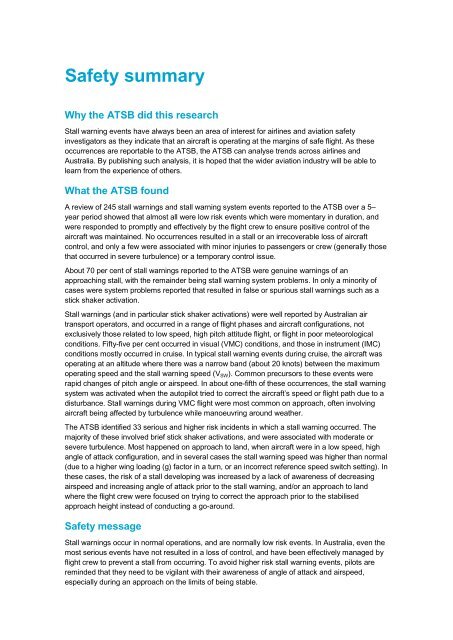Stall warnings in high capacity aircraft: The Australian context 2008 ...
Stall warnings in high capacity aircraft: The Australian context 2008 ...
Stall warnings in high capacity aircraft: The Australian context 2008 ...
You also want an ePaper? Increase the reach of your titles
YUMPU automatically turns print PDFs into web optimized ePapers that Google loves.
Safety summary<br />
Why the ATSB did this research<br />
<strong>Stall</strong> warn<strong>in</strong>g events have always been an area of <strong>in</strong>terest for airl<strong>in</strong>es and aviation safety<br />
<strong>in</strong>vestigators as they <strong>in</strong>dicate that an <strong>aircraft</strong> is operat<strong>in</strong>g at the marg<strong>in</strong>s of safe flight. As these<br />
occurrences are reportable to the ATSB, the ATSB can analyse trends across airl<strong>in</strong>es and<br />
Australia. By publish<strong>in</strong>g such analysis, it is hoped that the wider aviation <strong>in</strong>dustry will be able to<br />
learn from the experience of others.<br />
What the ATSB found<br />
A review of 245 stall <strong>warn<strong>in</strong>gs</strong> and stall warn<strong>in</strong>g system events reported to the ATSB over a 5–<br />
year period showed that almost all were low risk events which were momentary <strong>in</strong> duration, and<br />
were responded to promptly and effectively by the flight crew to ensure positive control of the<br />
<strong>aircraft</strong> was ma<strong>in</strong>ta<strong>in</strong>ed. No occurrences resulted <strong>in</strong> a stall or an irrecoverable loss of <strong>aircraft</strong><br />
control, and only a few were associated with m<strong>in</strong>or <strong>in</strong>juries to passengers or crew (generally those<br />
that occurred <strong>in</strong> severe turbulence) or a temporary control issue.<br />
About 70 per cent of stall <strong>warn<strong>in</strong>gs</strong> reported to the ATSB were genu<strong>in</strong>e <strong>warn<strong>in</strong>gs</strong> of an<br />
approach<strong>in</strong>g stall, with the rema<strong>in</strong>der be<strong>in</strong>g stall warn<strong>in</strong>g system problems. In only a m<strong>in</strong>ority of<br />
cases were system problems reported that resulted <strong>in</strong> false or spurious stall <strong>warn<strong>in</strong>gs</strong> such as a<br />
stick shaker activation.<br />
<strong>Stall</strong> <strong>warn<strong>in</strong>gs</strong> (and <strong>in</strong> particular stick shaker activations) were well reported by <strong>Australian</strong> air<br />
transport operators, and occurred <strong>in</strong> a range of flight phases and <strong>aircraft</strong> configurations, not<br />
exclusively those related to low speed, <strong>high</strong> pitch attitude flight, or flight <strong>in</strong> poor meteorological<br />
conditions. Fifty-five per cent occurred <strong>in</strong> visual (VMC) conditions, and those <strong>in</strong> <strong>in</strong>strument (IMC)<br />
conditions mostly occurred <strong>in</strong> cruise. In typical stall warn<strong>in</strong>g events dur<strong>in</strong>g cruise, the <strong>aircraft</strong> was<br />
operat<strong>in</strong>g at an altitude where there was a narrow band (about 20 knots) between the maximum<br />
operat<strong>in</strong>g speed and the stall warn<strong>in</strong>g speed (V SW ). Common precursors to these events were<br />
rapid changes of pitch angle or airspeed. In about one-fifth of these occurrences, the stall warn<strong>in</strong>g<br />
system was activated when the autopilot tried to correct the <strong>aircraft</strong>’s speed or flight path due to a<br />
disturbance. <strong>Stall</strong> <strong>warn<strong>in</strong>gs</strong> dur<strong>in</strong>g VMC flight were most common on approach, often <strong>in</strong>volv<strong>in</strong>g<br />
<strong>aircraft</strong> be<strong>in</strong>g affected by turbulence while manoeuvr<strong>in</strong>g around weather.<br />
<strong>The</strong> ATSB identified 33 serious and <strong>high</strong>er risk <strong>in</strong>cidents <strong>in</strong> which a stall warn<strong>in</strong>g occurred. <strong>The</strong><br />
majority of these <strong>in</strong>volved brief stick shaker activations, and were associated with moderate or<br />
severe turbulence. Most happened on approach to land, when <strong>aircraft</strong> were <strong>in</strong> a low speed, <strong>high</strong><br />
angle of attack configuration, and <strong>in</strong> several cases the stall warn<strong>in</strong>g speed was <strong>high</strong>er than normal<br />
(due to a <strong>high</strong>er w<strong>in</strong>g load<strong>in</strong>g (g) factor <strong>in</strong> a turn, or an <strong>in</strong>correct reference speed switch sett<strong>in</strong>g). In<br />
these cases, the risk of a stall develop<strong>in</strong>g was <strong>in</strong>creased by a lack of awareness of decreas<strong>in</strong>g<br />
airspeed and <strong>in</strong>creas<strong>in</strong>g angle of attack prior to the stall warn<strong>in</strong>g, and/or an approach to land<br />
where the flight crew were focused on try<strong>in</strong>g to correct the approach prior to the stabilised<br />
approach height <strong>in</strong>stead of conduct<strong>in</strong>g a go-around.<br />
Safety message<br />
<strong>Stall</strong> <strong>warn<strong>in</strong>gs</strong> occur <strong>in</strong> normal operations, and are normally low risk events. In Australia, even the<br />
most serious events have not resulted <strong>in</strong> a loss of control, and have been effectively managed by<br />
flight crew to prevent a stall from occurr<strong>in</strong>g. To avoid <strong>high</strong>er risk stall warn<strong>in</strong>g events, pilots are<br />
rem<strong>in</strong>ded that they need to be vigilant with their awareness of angle of attack and airspeed,<br />
especially dur<strong>in</strong>g an approach on the limits of be<strong>in</strong>g stable.
















